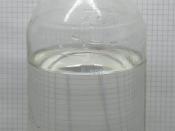Investigation:
How does the concentration affect the rate of a reaction?
Aim:
To investigate the effect of concentration on the rate of a chemical reaction between sodium thiosulphate solution and hydrochloric acid.
Reaction:
I will investigate the reaction between different concentrations of sodium thiosulphate solution with hydrochloric acid.
Na2S2O3(aq) + HCL(aq) = S(s) = H2O(l) + SO2(g) + NaCl(s)
(sodium thiosulphate + hydrochloric acid = sulphur + water + sulphur dioxide + sodium chloride)
Background Information
There are three ways of measuring the rate of reaction:
1. By observing the time taken for a precipitate to obscure a mark on a piece of paper/card.
2. Change in mass (usually caused by a gas being given off)
3. The volume of gas given off by using a syringe.
There are four factors that affect the rates of reaction:
1. Temperature.
2. Concentration (pressure in the case of a gas).
3. Size of particles (surface area).
4. Presence of a catalyst.
The collision theory is a way of explaining the above factors which effect the rate of reaction. The four factors can be explained in terms of increasing the number of collisions, and in terms of temperature, increases the rate at which collisions occur.
Temperature
When temperature is increased, the particles move more quickly, hence increasing the number of collisions. The temperature increase makes the particles move faster by giving them more energy. It is this way that collisions can happen at a faster rate.
The temperature will be controlled in this experiment. This is because we are only testing the effects of changing the concentration, and if the temperature varies too, we will not get an accurate result. We will make sure the temperature is the same all the way through.
Concentration (pressure)
If the solution is made more concentrated,


